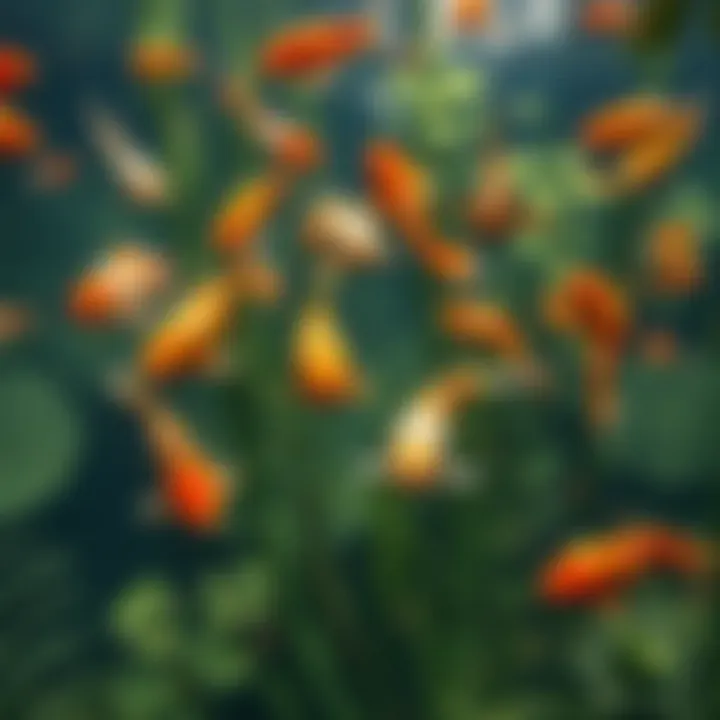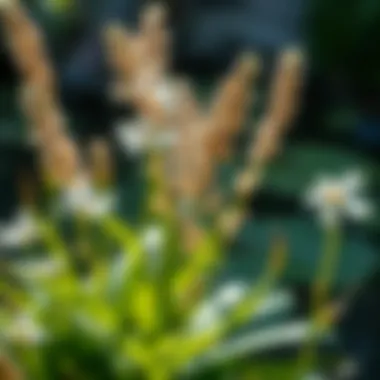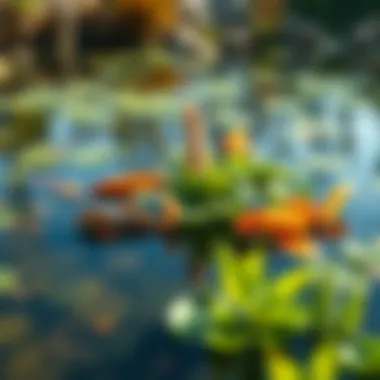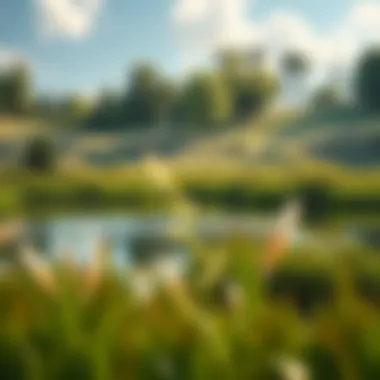Key Considerations for Stocking a New Pond


Overview of the Topic
Stocking a new pond is no idle endeavor. It represents an intricate interplay between nature’s balance and human ambition. For conservationists, students, and professionals in environmental studies, understanding how to create an aquatic ecosystem effectively is crucial. A well-stocked pond can foster a vibrant habitat teeming with life and growth. Yet, without proper considerations, efforts can easily veer off course—ending up with a pond that may struggle rather than thrive.
The Importance of Your Choices
When thinking about stocking a pond, choices of species cannot be overstated. The inhabitants of your pond will have far-reaching effects on its ecosystem. Introducing fish species like bass or bluegill without considering their ecological needs and relationships can lead to overpopulation or depletion of certain plant life.
Conservationists often emphasize the need to tailor selections based on local conditions: the pond's size, geographical location, and native flora and fauna all play pivotal roles. Additionally, introducing invasive species can wreak havoc, disrupting the delicate web of interactions that sustain a healthy aquatic environment. Therefore, taking the time to understand the synergy between various species is paramount to successful pond management.
Current Status and Challenges
Pond ecosystems today face several ongoing challenges. Over the past few decades, habitats have suffered due to human interference, pollution, and climate change. Many ponds have become overrun with algae due to nutrient runoff, creating a hostile environment for native species. Even well-meaning attempts at stocking can exacerbate these issues instead of alleviating them.
"The balance of nature can easily tip, often when we least expect it; an unchecked pond can lead to environmental collapse."
Moreover, the techniques employed in fish stocking have evolved, yet mismanagement persists. Many environmentally conscious individuals struggle to navigate the guidelines and regulations surrounding species introductions. This situation calls for a concerted effort not only to educate but to actively engage communities in sustainable practices.
Sustainable Solutions
Finding pathways to successful pond management doesn't have to be daunting. Several sustainable solutions are readily available:
- Pre-stock Assessments: Before introducing species, conduct tests for water quality and biodiversity to gauge existing conditions.
- Selection of Native Species: Opt for local species that have co-evolved with the surrounding ecosystems. They tend to require fewer resources and are better adapted to local conditions.
- Balanced Stocking Rates: Consider ecological dynamics and avoid overstocking. Effective strategies often recommend small, incremental introductions to monitor impact.
There are examples aplenty of successful pond stocking initiatives across the nation. For instance, the restoration efforts at the Lakeside Historic Park in Oregon have led to a resurgence of local aquatic species and improved community engagement with biodiversity efforts. This serves as a beacon for how strategic management can breathe life back into an ecosystem.
Impact and Importance
The ramifications of properly managed pond ecosystems extend beyond immediate aesthetics. These aquatic habitats serve essential functions, filtering pollutants and sequestering carbon, which is especially relevant in the face of climate change. Communities benefit as well; thriving ponds can become focal points for recreation, education, and conservation efforts fostering overall ecological awareness amongst residents.
In highlighting the importance of these ecosystems, we encourage conservation efforts that promote sustainable resource use, ensuring that future generations inherit a more balanced ecological landscape. Each step—from planning to execution—can lead to a healthier partnership with nature, granting us the opportunity to protect and enjoy the world around us.
To better understand these dynamics, resources can be found at EPA.gov, National Wildlife Federation, and Fish and Wildlife Service. These sites offer valuable insights into best practices and ongoing research in aquatic ecosystem management.
Prelims to Pond Stocking
When thinking about creating a pond, many factors come into play. Pond stocking revolves around the process of introducing various aquatic species to a newly created or existing pond. While this might sound straightforward, there's a lot of depth to it that isn't immediately apparent. With the right approach, pond stocking can transform a barren body of water into a thriving ecosystem. Understanding the nuances of selecting appropriate species and considering the health of the overall ecosystem is crucial for long-term sustainability.
Defining Pond Stocking
Pond stocking might best be understood through a simple definition: it basically refers to the introduction of fish and other aquatic organisms to a pond. However, it goes beyond just throwing a handful of fish into the water. Several factors color this seemingly simple act.
First, there’s a variety of organisms to consider. This includes not just fish but also amphibians, invertebrates, and aquatic plants. Each of these plays a unique role in the ecosystem, and choosing the right mix can significantly influence the pond's health. For instance, if you introduce too many predators without enough prey, this imbalance might lead to a collapse of the fish population over time.
Second, understanding the physical and chemical properties of the pond is equally important. Stocking too quickly, without taking water quality or existing wildlife into consideration, can lead to dire consequences. Everything from the pond’s pH levels to its size and depth can impact the success of a stocking effort.
Importance of Stocking in Ecosystem Health
The significance of proper pond stocking cannot be overstated. By introducing the right species in the right quantities, you help maintain a balanced aquatic ecosystem that is resilient and self-sustaining. Here are some key benefits to consider:
- Biodiversity: Stocking can enhance species diversity, creating a healthier environment for all organisms. The greater the variety, the more stable the ecosystem in the face of changes.
- Food Web Integration: When you properly select species, you're laying down the groundwork for a natural food web. For example, if you introduce both predator and prey species, the natural balance allows populations to thrive without collapsing.
- Nutrient Cycling: The inclusion of various species aids in the cycling of nutrients. Plants, for instance, absorb nutrients and provide oxygen, while fish help maintain water quality through their natural behaviors.
- Recreation and Aesthetics: From a community standpoint, a well-stocked pond can offer recreational opportunities like fishing, while also serving as a beautiful element of the landscape.
A well-stocked pond isn't just an aesthetic addition—it's a cornerstone of ecological health that can provide lifelong benefits to surrounding wildlife and the community alike.
In summary, stocking a pond is much more than a simple endeavor; it requires careful planning and consideration. It connects to larger topics in environmental science, pushing individuals to think about how our interactions with nature can lead to sustainable practices. In the following sections, we will delve deeper into essential ecological considerations for success.
Ecological Considerations
When considering the meticulous endeavor of stocking a new pond, one cannot overlook the vital ecological considerations involved in this process. The establishment of a balanced aquatic ecosystem is not merely an act of adding fish or other wildlife; it’s about fostering a sustainable environment that can thrive harmoniously. Hence, understanding the existing ecological conditions, recognizing the impact of invasive species, and appreciating the role of biodiversity are crucial. These elements collectively contribute to the longevity and health of the pond.
Assessing Existing Ecosystem Conditions
Before diving into stocking decisions, it's imperative to assess the current state of the ecosystem within the pond. This initial evaluation serves as a foundation for informed decisions regarding species introduction.
- Water Quality: Parameters such as pH, temperature, and dissolved oxygen levels need careful scrutiny. For instance, a pond with a high nutrient load may experience algal blooms, which can devastate local aquatic life. Regular testing can provide a clear picture of water health.
- Substrate Composition: The bottom of the pond, whether it's sandy, muddy, or rocky, will dictate the types of organisms that can thrive. A diverse substrate can support various life forms.
- Existing Flora and Fauna: Surveying plant and animal life is essential. Not only does it tell you what is already there, but it helps you understand the interdependent relationships that are vital for an ecosystem's stability.
By carrying out these assessments, you're not just checking boxes; you're setting the stage for a thriving aquatic community.
Impact of Invasive Species
Invasive species can wreak havoc on local ecosystems, often outcompeting native organisms and disrupting the balance of the pond's ecosystem. These outsiders can introduce diseases, reduce biodiversity, and even alter the physical environment.
- Species Identification: Documentation of any red flags—non-native or harmful species—should be prioritized. Something as simple as a water plant introduced for aesthetic purposes can quickly dominate and choke out the native flora.
- Management Strategies: Depending on the extent to which invasive species have permeated the ecosystem, various approaches could be employed—ranging from physical removal to controlled herbicide application.


The adage "an ounce of prevention is worth a pound of cure" rings truer in aquatic management than in many other fields; it’s essential to act swiftly to mitigate risks from invasive species.
Biodiversity and Its Importance
Biodiversity serves as the bedrock of a healthy pond ecosystem. A variety of species can enhance stability and resilience, making the ecosystem better equipped to withstand environmental changes.
- Food Web Dynamics: Numerous species at different trophic levels contribute to a balanced food web. For instance, plants and phytoplankton provide energy for herbivores, while predators such as bass help control fish populations.
- Ecosystem Services: Diverse ecosystems offer benefits like natural filtration, nutrient cycling, and habitat provision for various wildlife, boosting overall productivity.
- Community Interaction: Engaging local students, conservationists, or even everyday folk in conservation efforts can foster a sense of stewardship, promoting further awareness about biodiversity.
In summary, keeping biodiversity at the forefront is essential for maintaining a robust aquatic ecosystem.
"A rich tapestry of life in a pond leads not only to ecological balance but also to a more resilient environment capable of thriving in the face of adversity."
Incorporating these ecological considerations into your pond management practices not only enhances the health of aquatic environments but also contributes significantly to broader conservation efforts.
Choosing the Right Species
Selecting the appropriate species for your pond is a pivotal step in ensuring the success and stability of the aquatic ecosystem you are curating. It goes beyond merely populating the water with fish or plants; it's about constructing a thriving web of life that balances interactions and promotes biodiversity. Making informed decisions here can lead to a harmonious pond where every life form plays its part, from the smallest microorganisms to the larger fish. In this section, we will explore key considerations regarding native versus non-native species, their compatibility, and how to select species that meet specific environmental goals.
Native vs. Non-Native Species
When deciding on species for your pond, one of the first choices you face is whether to introduce native or non-native species. *Native* species are those that naturally occur in a particular region, adapted to the local environment and its associated challenges. They often possess a natural resilience to local diseases, parasites, and predators. By choosing native species, you not only support the ecosystem but also contribute to local biodiversity, which is essential in maintaining ecological balance.
On the other hand, *non-native* species—those introduced from different regions or countries—may offer aesthetic variety or appeal for sport fishing. However, they can act as double-edged swords. These species may thrive in new environments, outcompete local fish, and even cause habitat degradation by disrupting food webs. A wise pond manager carefully weighs the benefits against potential ecological risks before introducing any non-native life forms.
"In the world of pond management, the choices we make echo throughout every ripple in the water."
Species Compatibility and Relationships
It's not just about individual species; it's crucial to consider how these organisms interact with each other. Fish, plants, and other organisms all share a complex web of relationships that affect their growth and survival. *Compatibility* among species can lead to a more robust ecosystem, as some species provide shelter or food for others while maintaining balance. For instance, larger fish like bass can control populations of smaller fish like bluegill, preventing them from overcrowding the pond.
When selecting species, consider the predator-prey dynamics, growth rates, and habitat needs. Some fish may require specific depths for spawning, while others might need vegetation for shelter. Having a mix of different species can promote stability—think of it as creating a miniature community that fosters opportunities for collaboration instead of competition.
Selecting Species for Desired Outcomes
The end goal is what matters—what do you envision for your pond? Whether you aim to create a serene habitat for wildlife, a vibrant fishing hotspot, or simply a beautiful natural feature, your choice of species will direct your path toward success. Each species brings a unique set of benefits and characteristics, so align your selections with your goals.
- For Biodiversity: Focus on a variety of native aquatic plants and fish. Species such as lilies can provide essential cover, while native minnows can support larger predatory fish.
- For Recreation: Consider adding species like trout or catfish, depending on your local climate, so you can balance enjoyment with ecological integrity.
- For Ecosystem Balance: Incorporate detritivores like snails and certain types of crayfish that can help maintain water quality by breaking down organic materials.
In all, every choice made in species selection has rippling effects throughout the ecosystem. Careful consideration and research, combined with an awareness of local ecological needs, will stand you in good stead as you populate your pond.
Setting Up for Stocking
Establishing a proper foundation for a new pond goes beyond simply adding water and fish. Setting up for stocking is a critical phase in developing a healthy aquatic ecosystem. It involves careful consideration of multiple factors that can affect the pond's balance and overall biodiversity. A well-prepared environment can lead to successful species acclimatization and sustainability. If not handled with care, you could end up creating more headaches down the line.
Preparing the Pond Environment
Before stocking fish, it’s essential to create an environment that supports their growth and reproduction. Start by assessing your pond’s physical features — the depth, surrounding vegetation, and substrate composition can all impact aquatic life. Ideally, your pond should have a variety of depths, offering both shallow areas and deep spots. Shallow water heats up faster, making it a great nursery for young fish.
Adding native plants not only provides habitat but also contributes to water quality. These natural guardians help stabilize the soil and reduce erosion. Additionally, they act as natural filters for nutrients, making it less likely for the pond to become overrun by algae.
To summarize the preparation steps:
- Assess depth and shape: Create diverse habitats
- Incorporate aquatic plants: Support water quality and habitat
- Monitor shoreline: Prevent erosion and runoff
Monitoring Water Quality Parameters
Maintaining optimal water quality is like keeping your engine tuned; without regular checks, what once worked smoothly could begin to stall. Testing for key parameters such as pH, dissolved oxygen, ammonia levels, and temperature ensures that the environment is safe for the species you plan to introduce. Each species has specific requirements, and knowing these can help you avoid any trial and error situations.
You should invest in a quality water testing kit to simplify this process. Regular checks are essential, especially during the initial phases after stocking. Make adjustments as necessary, adopting strategies like aeration for low oxygen levels or adding buffers to stabilize pH. Remember to check:
- Dissolved oxygen: Vital for fish health
- pH levels: Aim for neutrality, between 6.5 to 8.5
- Temperature stability: Prevent shock during seasonal changes
Logistics of Transporting Stocking Species
Transport logistics may feel like a minor detail, but mishaps can lead to considerable stress. When acquiring fish or other aquatic species, handling is crucial. Make sure you have suitable containers for transport — think survival tanks, where water can be kept aerated and thermally stable. Avoid using plastic bags which can trap heat and increase ammonia levels. Instead, consider insulated boxes or coolers filled with water from the source pond.
Timing can also play a vital role, so try to minimize transport time. Plan ahead and be in touch with suppliers or hatcheries to coordinate timely pickup and drop-off. Moreover, being mindful of temperature differentials is key. If you are transporting cool-water species during hot months, ensure that their environment remains as consistent as possible.
Here’s a quick checklist for transporting species effectively:
- Use insulated containers: Maintain stable temperature
- Limit transport time: Aim for swift transitions
- Prepare aeration measures: Keep oxygen levels intact
Successful stocking is predicated on meticulous preparation and responsive monitoring. The attention you give now will pay dividends in ecosystem health down the road.
These carefully structured steps ease the initial loading phase of your pond’s journey. Proper setup not just protects the species but also secures your efforts toward creating a flourishing aquatic community.


Stocking Techniques
Stocking techniques involve a careful blend of timing, methods, and ongoing management; these elements are vital in creating a thriving aquatic ecosystem. The way species are introduced and cared for can make or break the delicate balance of pond life. Mastering these techniques allows conservationists and environmentalists to foster a habitat that supports diverse flora and fauna. It’s not just about tossing fish into water; it’s about scientific precision and practicality intertwined for the health of an ecosystem.
Timing and Conditions for Stocking
Getting the timing right for stocking is crucial. Ideally, introducing species should align with seasonal changes to ensure the best chances of survival and growth. Late spring to early summer often provides warmer water temperatures, allowing new residents to acclimate more easily. However, temperature isn't the only factor. Weather conditions also play a significant role in successful stocking. For example, it's beneficial to stock before rain; this can lead to a more gradual introduction and a reduction in shock levels for the new species.
Some considerations include:
- Water Temperature: Species can experience shock if the water temperatures differ drastically between the transport container and the pond.
- Oxygen Levels: Make sure the oxygen levels are adequate before introducing new fish; lower levels can stress the animals.
- Vegetation: The presence of natural vegetation can help stabilize both temperature and oxygen levels during the initial phases post-stocking.
“The best timing can add years to a pond’s ecosystem health, while poor choices can result in biological chaos.”
Methods of Introducing Species
Several methods exist for introducing species, each depending on the goals, species type, and pond conditions. Two primary approaches are bucket stocking and live wells. While bucket stocking is straightforward, live well stocking allows for a gradual acclimatization process that reduces stress on the species being introduced.
Here are common methods:
- Bucket Stocking: A quick method, but it requires careful preparation of the water in the bucket to match the pond conditions.
- Live Well Stocking: Ideally for larger fish; this method helps fish gradually adapt to the new environment.
- Using a Fish Stocking Truck: For large-scale efforts, specialized fish hauling trucks can deliver fish directly to the pond, minimizing stress during transport.
Regardless of the method chosen, respecting the species' natural behavior is paramount. For instance, schooling species might benefit from being introduced in groups rather than one by one.
Post-Stocking Care and Observation
Once the stocking is done, the work doesn’t stop there. Monitor the new inhabitants closely to gauge how well they are adapting. This phase is often overlooked, but it’s critical to ensure species thrive in their new home. Regular checks on water quality, food availability, and signs of stress in the fish population can provide early warnings of issues.
Key practices to consider:
- Regular Water Testing: This should include checking for pH, ammonia, nitrites, and nitrates regularly to ensure a balanced ecosystem.
- Feeding: Depending on the species, providing a supplemental diet can help as they adjust.
- Behavioral Observations: Keep an eye out for signs of stress in fish, like erratic swimming or lethargy. These can be indicators of larger issues within the habitat.
Management techniques will vary but should always promote the sustainability of the ecosystem. The more informed the introduction, the easier it will be to maintain a healthy aquatic life.
For more resources related to aquatic ecosystem management, consider visiting EPA.gov or National Park Service.
Management of Stocked Ponds
Effective management of a stocked pond is akin to a maestro conducting an orchestra. Each element must harmonize to create a thriving aquatic ecosystem. This section underscores the importance of proper management and touches on key components like monitoring, addressing competition, and recalibrating stocking ratios. Without diligent oversight, your hard work in stocking could easily go awry, leaving the ecosystem imbalanced and struggling to survive.
Regular Monitoring and Maintenance
Regular monitoring and maintenance are vital for ensuring the vitality of a newly stocked pond. Think of it as the routine check-ups you might undergo to keep your health in check. By performing routine assessments on the water quality—checking parameters like pH, dissolved oxygen levels, and nutrient concentrations—you can catch potential issues before they spiral out of control.
Some key practices for effective monitoring include:
- Weekly Water Testing: Conduct tests for pH, ammonia, nitrite, and nitrate levels. Being proactive about water quality ensures any emerging problems can be handled swiftly.
- Observing Fish Behavior: Watching for signs of stress in fish, such as abnormal swimming patterns or lethargy, can provide insights into underlying problems in the pond ecosystem.
- Maintenance of Structures: Regular upkeep of any introduced structures, like islands or submerged habitats, helps maintain natural cover for fish and other aquatic organisms, enhancing their habitat.
Maintaining a regular schedule not only ensures ecological balance but also fosters biodiversity, which is fundamental for a robust pond environment.
Dealing with Competition and Predation
Introducing new species into a pond may seem relatively straightforward, but dealing with competition and predation post-stocking can present unexpected challenges. Think of your pond as a bustling neighborhood, where all residents vie for the same resources—food, habitat, and space. Without proper management, competition can quickly lead to a decline in native species.
Some approaches to manage these issues include:
- Introducing Predators Consciously: While including predators like bass can help control smaller fish populations, it's imperative to do so with careful consideration. An overabundance of predators can lead to depletion of prey species, tipping the balance.
- Creating Refuge Areas: Introducing structures such as rocks, vegetation, or artificial shelters can provide crucial hiding places for smaller fish, reducing their vulnerability to predation.
- Monitoring Stakeholders' Impact: Regularly engage with community members who may fish or interact with the pond. Their activities can significantly affect fish populations and the overall ecological balance.
By maintaining vigilance and adjusting strategies as necessary, pond managers can create an environment where all species can thrive, supporting the overall health of the ecosystem.
Adjusting Stocking Ratios Over Time
Pond ecosystems are dynamic. As the ecosystem grows and develops, there's a strong likelihood that initial stocking ratios may not yield the desired effects. This is where adjusting stocking ratios becomes essential. Imagine that you’ve opened a new restaurant; to understand which dishes are favored, you would need to refine the menu based on customer feedback. Similarly, adapting to your pond's evolving needs is crucial.
Consider these strategies:
- Evaluate Population Dynamics: Assess the existing populations periodically. If certain species are thriving while others are dwindling, reevaluate their ratios to accommodate a more balanced ecosystem.
- Introduce Species Gradually: When adjusting ratios, consider introducing new species in smaller, controlled batches. This method allows you to monitor impacts more carefully without destabilizing the entire pond.
- Feedback Loop: Use feedback from ongoing monitoring as a guide for adjustments. If fish populations seem to be collapsing, immediate action may involve rebuilding those populations or decreasing competitors.
In summary, management of stocked ponds requires ongoing engagement and adaptation. By emphasizing regular monitoring, dealing with competition and predation, and fine-tuning stocking ratios, one can work toward a balanced and sustainable aquatic ecosystem.
Community Involvement and Education
Engaging local communities in pond stocking initiatives can signal the difference between success and failure. Conservationists often overlook this dimension, yet it proves pivotal not only for ecological outcomes but also for fostering long-term sustainability. When individuals in the community understand the ecological significance of their efforts and receive proper education, they become champions for aquatic health and biodiversity.


Engaging Local Stakeholders
Identifying and involving key local stakeholders creates a more resilient aquatic ecosystem. These stakeholders include local governments, fishing clubs, schools, and environmental groups. Here's how you can enrich participation:
- Awareness Campaigns: Create informative sessions that highlight the benefits of aquatic ecosystems. Engaging storytelling about local wildlife and ecosystem functions not only draws interest, but fosters emotional investment.
- Partnerships: Collaborating with local schools and universities can amplify education efforts. Think about organizing field trips or workshops where students can learn practical skills related to pond management or species identification.
- Lister to Concerns: Stakeholders often have valuable insights regarding local conditions and challenges. Make sure to listen actively and incorporate their feedback into plans. This two-way interaction nurtures a sense of ownership among participants, turning them into stewards of the pond.
Overall, local engagement brings multiple perspectives into the conversation, encouraging a sense of community pride and responsibility toward environmental sustainability.
Educational Programs on Aquatic Ecosystems
Implementing educational programs serves multiple purposes, including raising awareness and equipping individuals with necessary tools for pond management. These programs can vary widely in format and content:
- Workshops and Seminars: Organizing hands-on workshops where participants can learn about water quality monitoring, species compatibility, and ecological balance is crucial. Participants not only grow in knowledge, but they can apply these principles directly to ongoing projects.
- Online Resources: Developing accessible online content can cater to a wider audience, including those who may not be able to attend local events. Creating a website or social media pages dedicated to local ecosystems can help distribute vital information regularly.
- Involvement in Research: Run initiatives that allow community members to engage with ongoing research. It could be a simple task, like recording fish populations or water parameters, which educates while gathering useful data.
By layering community involvement with structured educational programs, we pave the way for more informed decision-making. Local participants who feel connected to the program are more likely to invest time and energy into its success.
An informed community sustains not just a pond but cultivates a culture of conservation.
In summary, fostering relationships with local stakeholders and developing comprehensive educational programs serves as a backbone for successful pond stocking practices. Collectively, these approaches can lead to healthier ecosystems that are not only sustainable today but also safeguarded for future generations.
Case Studies and Practical Examples
Examining the rise and fall of different pond stocking practices provides a profound understanding of what truly works in aquatic ecosystem management. It’s not just theory; it’s about learning through real-world applications, successes, and pitfalls. Case studies serve as a testament to the concept that knowledge is best gained from experience, both good and bad. Taking a closer look at these narratives can illuminate the critical components needed for successful pond stocking – a necessary journey for conservationists, students, and environmentalists alike.
Successful Examples of Pond Stocking
Across the globe, there are outstanding examples where effective pond stocking led to thriving ecosystems. For instance, in France, the enhancement of the Lac du Bourget was achieved through a strategic stocking of native fish species like the grayling and the perch. Here, careful assessment of local water conditions and species compatibility set the stage for a flourishing aquatic community.
- Key factors contributing to the success:
- Site-specific Approaches: Rather than a one-size-fits-all strategy, the project was tailored according to the specific ecology of the lake.
- Community Involvement: Local fishermen were engaged to help monitor fish populations and report back on the ecosystem's health.
- Continued Research: Ongoing studies allowed for adaptive management strategies that adjusted stocking rates based on observed outcomes.
Another noteworthy example can be found in the United States, particularly in the restoration efforts in the Great Lakes region. Here, the reintroduction of native brook trout was undertaken after extensive habitat rehabilitation. The management teams learned from previous failed attempts and adapted their techniques, focusing on environmental compatibility and local climate conditions.
"Success in aquatic ecosystem management often comes down to understanding the local environment, not just throwing fish into the water and hoping for the best."
These examples provide valuable lessons on species selection, ongoing monitoring, and the importance of habitat. They show that when communities work hand-in-hand with science, they can bring back species that were once on the brink.
Lessons Learned from Failed Stocking Attempts
The road to effective pond stocking isn’t always smooth. Various case studies highlight instances where well-intentioned efforts backfired. Understanding these failures contributes immensely to refining future strategies. One example from Canada showed how the introduction of perch without prior ecological assessment disrupted local ecosystems, leading to the decline of native species like the indigenous minnow.
- Factors behind the failure:
- Neglected Ecological Assessments: Lack of proper evaluation of existing species led to competition and eventual decline of native fish.
- Uncontrolled Reproduction: The introduced species out-competed local fish for resources, which resulted in unexpected shifts in the food web.
- Insufficient Monitoring: Post-stocking monitoring was inadequate, leaving no room for adaptive management methods to be implemented.
Another cautionary tale comes from a pond project in the UK where excessive stocking of carp was conducted without considering the pond’s carrying capacity. The result was a dramatic decrease in water quality and biodiversity due to overpopulation and the associated environmental degradation.
"Not all stocking is successful. Lessons from failure shape our understanding and practices towards better ecological management."
These failures underscore the need for rigorous planning, community education, and ongoing evaluation of stocking practices.
In summary, real-world examples from successful and failed pond stocking attempts inform best practices in aquatic ecosystem management. They remind us that stocking isn't merely about filling a pond; it’s an intricate dance between species and their environment, one that requires careful consideration at every step.
End
Stocking a new pond isn’t just about plopping some fish in water and calling it a day. It demands a thoughtful approach rooted in ecological principles, social responsibility, and ongoing management. The process carries weighty significance, not only for the aquatic inhabitants but also for the broader ecosystem, which can be affected in surprising ways. A well-executed stocking plan builds resilience in local wildlife, enhances biodiversity, and supports the health of the surrounding environment.
One of the central points highlighted throughout this article is the importance of aligning species selection with native ecosystems. This consideration influences not just immediate populations but also long-term ecological balance. Moreover, understanding the dynamics of your water body before introducing any species can make a world of difference. This is no small feat—each decision made at the outset can echo downstream, impacting everything from plant life to water quality.
Additionally, the value of community involvement cannot be overstated. Engaging local stakeholders fosters a sense of shared stewardship and education. Informing community members about the goals and practices in pond management can spark interest, leading to collaborative efforts that help safeguard these precious ecosystems.
In essence, effective pond management necessitates ongoing observation, education, and adaptation. Changing conditions often require swift responses to maintain balance in the ecosystem.
"Sustainable practices in pond stocking not only contribute to ecosystem integrity but also empower communities to connect with their natural environments."
By collecting the lessons from past successes and failures in pond stocking, we can approach similar initiatives with greater precision and insight, ultimately ensuring that future efforts align with best practices in sustainability and biodiversity.
Recapping Key Takeaways
As this article unfolds, a few distinct takeaways become apparent:
- Understanding your local ecosystem is essential before stocking.
- Prioritize native species to maintain ecological balance.
- Regular monitoring and community involvement contribute significantly to sustainable practices.
- Adjust and adapt management strategies based on outcomes and environmental changes.
Future Directions in Pond Stocking Practices
Looking ahead, the field of aquatic ecosystem management is ripe for innovation and deeper research. Emerging technologies—like real-time water quality sensors—offer new ways to monitor ecosystems more effectively, allowing for timely interventions when needed. Furthermore, participatory approaches that involve community feedback in stocking practices may yield valuable insights, as on-the-ground experiences can often reveal nuances that scientific studies may overlook.
Continued research into the effects of climate change on aquatic ecosystems will help refine stocking practices. As temperature fluctuations and weather variability impact water bodies, understanding these factors will be key to developing species distributions and stocking strategies that are resilient to change.
At the same time, partnerships and collaborations can help share resources and knowledge, paving the way for a more sustainable future. Engaging with academic institutions and conservation organizations could provide valuable insights into best practices and cutting-edge research.



